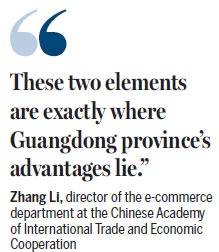Commerce set for big expansion
Advantages in logistics and payment services put southern Guangdong province in an ideal position to develop cross-border e-commerce business along the routes of the Belt and Road Initiative, academics and industry insiders said on Wednesday.
"In the cross-border e-commerce industry, there is a popular saying: 'the supply chain is king,'" said Zhang Li, director of the e-commerce department at the Chinese Academy of International Trade and Economic Cooperation, a think tank affiliated with the Ministry of Commerce.
Logistics and payment services are two vital parts to a sound supply chain, she said. "These two elements are exactly where Guangdong province's advantages lie," Zhang told a forum in Zhuhai on Wednesday, with the theme that the 21st century maritime silk road reshapes trade patterns.
The event was connected to the first 21st Century Maritime Silk Road Forum on International Communication and Chinese (Guangdong) Companies Going Global.
It was co-sponsored by the information office of the Guangdong provincial government and the Zhuhai government.
Guangdong is also taking the lead in the manufacturing of 3C products: computer, communications and consumer electronics, Zhang added.

"The province could integrate its core advantages in 3C manufacturing with its strengths in logistics and payments, to develop cross-border e-commerce business in Belt and Road countries and regions," Zhang said.
Driven by Chinese people's increasing income and growing demand for overseas commodities, cross-border e-commerce has grown rapidly in China in recent years.
According to official statistics, the market grew by 30 percent year-on-year on average from 2008 to 2015.
The market further expanded last year, as popularity for overseas online shopping platforms continues to rise. Turnover amounted to 6.3 trillion yuan ($954 billion) in 2016, with the number of Chinese shoppers on overseas platforms reaching 41 million.
Industry research firm CI Consulting predicted that China's cross-border e-commerce turnover will account for 37.6 percent of the country's total import and export volumes by 2020.
To achieve that, the Chinese government and domestic enterprises should bear their own responsibilities, according to Wang Zuo, vice-president and senior researcher of the China Society of Logistics Management.
"While the government needs to maintain supply chain security and protect Chinese enterprises' overseas assets, Chinese enterprises need to comply with the laws, regulations, religions, cultures and social customs in their host countries," he said.
Zhang Guangnan, a professor at the Institute of Guangdong, Hong Kong and Macao Development Studies at Sun Yat-sun University, said it is important to see things from a broad perspective.
The construction of the Guangdong-Hong Kong-Macao Greater Bay Area will promote cross-border trade between China and Belt and Road countries and regions, but challenges remain in terms of risk control as the Chinese economy becomes more open, he noted.
"The government's adoption of the negative-list management model, allowing overseas investors to enter more fields, could welcome more opportunities brought about by openness, while at the same time creating potential for more risks," Zhang said.
"Risk management is an important issue we need to address in order to ensure trade grows healthily."
(China Daily 12/04/2017 page12)



 Print
Print Mail
Mail

